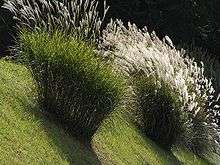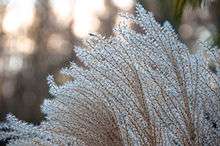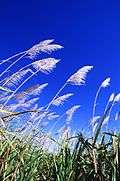Miscanthus
| Miscanthus | |
|---|---|
 | |
| Miscanthus sinensis | |
| Scientific classification | |
| Kingdom: | Plantae |
| (unranked): | Angiosperms |
| (unranked): | Monocots |
| (unranked): | Commelinids |
| Order: | Poales |
| Family: | Poaceae |
| Subfamily: | Panicoideae |
| Tribe: | Andropogoneae |
| Genus: | Miscanthus Andersson |
| Type species | |
| Miscanthus capensis | |
| Synonyms[3] | |
| |
Miscanthus, silvergrass,[4] is a genus of African, Eurasian, and Pacific Island plants in the grass family.[5][6]
The species Miscanthus sinensis is widely cultivated as an ornamental grass, and is the source of several cultivars.
- Miscanthus changii Y.N.Lee – Korea
- Miscanthus depauperatus Merr. – Philippines
- Miscanthus ecklonii (Nees) Mabb. – southern Africa
- Miscanthus floridulus – China, Japan, Southeast Asia, Pacific Islands
- Miscanthus fuscus (Roxb.) Benth. – Indian Subcontinent, Indochina, Pen Malaysia
- Miscanthus junceus – southern Africa
- Miscanthus lutarioriparius L.Liu ex S.L.Chen & Renvoize – Hubei, Hunan
- Miscanthus nepalensis (Trin.) Hack. – Indian Subcontinent, Tibet, Yunnan, Myanmar, Vietnam, Pen Malaysia
- Miscanthus nudipes (Griseb.) Hack. – Assam, Bhutan, Nepal, Sikkim, Tibet, Yunnan
- Miscanthus × ogiformis Honda – Korea, Japan
- Miscanthus oligostachyus Stapf. – Korea, Japan
- Miscanthus paniculatus (B.S.Sun) S.L.Chen & Renvoize – Guizhou, Sichuan, Yunnan
- Miscanthus sacchariflorus – Korea, Japan, northeastern China, Russian Far East
- Miscanthus sinensis – Korea, Japan, China, Southeast Asia, Russian Far East; naturalized in New Zealand, North + South America
- Miscanthus tinctorius (Steud.) Hack. – Japan
- Miscanthus villosus Y.C.Liu & H.Peng – Yunnan
- Miscanthus violaceus (K.Schum.) Pilg. – tropical Africa
- formerly included[3]
see Chloris Pseudopogonatherum Saccharum Spodiopogon
- Miscanthus affinis – Pseudopogonatherum quadrinerve
- Miscanthus cotulifer – Spodiopogon cotulifer
- Miscanthus polydactylos – Chloris elata
- Miscanthus rufipilus – Saccharum rufipilum
- Miscanthus tanakae – Pseudopogonatherum speciosum
Uses
M. giganteus
The sterile hybrid between M. sinensis and M. sacchariflorus, Miscanthus giganteus, has been trialed as a biofuel in Europe since the early 1980s. It can grow to heights of more than 3.5 m in one growth season. Its dry mass annual yield can reach 25 tonnes per hectare (10 tonnes per acre).[8] It is sometimes called "Elephant Grass", and so is often confused with the African grass Pennisetum purpureum, colloquially known by the same name.
The rapid growth, low mineral content, and high biomass yield of Miscanthus make it a favorite choice as a biofuel.[9] Miscanthus can be used as input for ethanol production, often outperforming corn and other alternatives in terms of biomass and gallons of ethanol produced. Additionally, after harvest, it can be burned to produce heat and steam for power turbines. In addition to the amount of CO2 emissions from burning the crop, any fossil fuels that might have been used in planting, fertilizing, harvesting, and processing the crop, as well as in transporting the biofuel to the point of use, must also be considered when evaluating its carbon load. Its advantage, though, is that it is not usually consumed by humans, making it a more available crop for ethanol and biofuel, than, say, corn and sugarcane. When mixed 50%-50% with coal, Miscanthus biomass can be used in some current coal-burning power plants without modifications.
Miscanthus has also been suggested as a "green" building material, for both wall construction and general insulation. An experimental house based on Miscanthus straw bales was under construction in 2017.[10]
M. sinensis

M. sinensis is cultivated as an ornamental plant. In Japan, where it is known as susuki (すすき), it is considered an iconic plant of late summer and early autumn. It is mentioned in Man'yōshū (VIII:1538) as one of the seven autumn flowers (aki no nana kusa, 秋の七草). It is used for the eighth month in hanafuda playing cards. It is decorated with bush clover for the Mid-Autumn Festival. Miscanthus has also excellent fiber properties for papermaking.
References
- ↑ lectotype designated by Coville, Contr. U.S. Natl. Herb. 9: 400 (8 Apr 1905)
- ↑ Tropicos, Miscanthus Andersson
- 1 2 3 Kew World Checklist of Selected Plant Families
- ↑ "Miscanthus". Natural Resources Conservation Service PLANTS Database. USDA. Retrieved 13 July 2015.
- ↑ Andersson, Nils Johan. 1855. Öfversigt af Förhandlingar: Kongl. Svenska Vetenskaps-Akademien 12: 165.
- ↑ Flora of China Vol. 22 Page 581 芒属 mang shu Miscanthus Andersson, Öfvers. Kongl. Vetensk.-Akad. Förh. 12: 165. 1855.
- ↑ The Plant List search for Miscanthus
- ↑ National Non-Food Crops Centre. "NNFCC Crop Factsheet: Miscanthus". Retrieved on 2011-02-17.
- ↑ Scurlock, J. M. O. (February 1999). "Miscanthus: a review of European experience with a novel energy crop". Oak Ridge National Laboratory, U.S. Department of Energy. Archived from the original on 2009-04-13. Retrieved 2009-06-01.
- ↑ Blog of Centre for Alternative Technology in Wales: "The world’s first Miscanthus bale house". Retrieved 2017-11-27
External links
- UK's National Centre for Biorenewable Energy, Fuels and Materials
- Miscanthus x giganteus - as an energy crop - Miscanthus Research at the University of Illinois
- - New Energy Farms - Miscanthus developers and suppliers
- - Terravesta - The complete supply chain solution for Miscanthus Europe.
